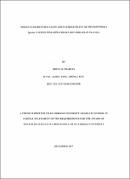Molecular identification and pathogenicity of phytophthora species causing pineapple heart rot disease in Uganda
Abstract
Pineapple (Ananas cosmosus L.Merrill) has enormous potential for nutritional and health
benefits, foreign exchange earnings, industrial growth and development in Uganda. The
production of this crop is on the decline, because of outbreak of the pineapple heart rot
disease. Therefore the objective of this study was to determine the molecular identity and
pathogenicity of the phtophthora causal organism of pineapple heart rot disease. Four major
pineapple growing districts in Central Uganda were surveyed for disease prevalence and
samples collected for laboratory isolation and characterization between April-May 2016.
Twenty one (2 1) sampies of phytophthora heart rot pathogen were isolated from diseased
pineapple tissues. Pathogenicity of the pineapple heart rot causal organisms was assessed on
invitro pineapple leaves and green apple fruits in laboratory following koch'spostulate.
Internal transcribed spacer regions (ITSI, 5.8s !TSUrDNAs, from I I isolates of phy10phthora
were analysed by polymerase chain reaction amplification and direct sequencing. The
analysis of molecular variance (AMOVA) showed a significant genetic diversity within
population (PhiPT= -O.Q68, P= 0.001). Intraspecific variability was detected. The genetic
diversity of the population was measured by building phylogeneies based on these sequenced
rDNA-ITS data using Muiltiple sequence alignment tool. The results of the pathogenicity test
showed that 100% of the isolates were pathogenic apple fruits and healthy pineapple leaves
with varying levels of virulence. Based on molecular identification, the sequence of amplified
PCR products of DNA fragment of 850bp confined that the causal organism of pineapple
heart rot disease was Pnicotianae. AMOVA indicated the variability within populations was
(100%). These results also suggest that Pnicotianae has considerable evolutionary potential,
which enable it to adapt to the new environment and overcome management strategies over

